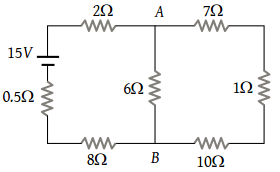The reading of the ammeter as per figure shown is

(1)
(2)
(3)
(4) 2 A

Equivalent resistance between A and B will be
(1) 2 ohm
(2) 18 ohm
(3) 6 ohm
(4) 3.6 ohm
The equivalent resistance of resistors connected in series is always :
(1) Equal to the mean of component resistors
(2) Less than the lowest of component resistors
(3) In between the lowest and the highest of component resistors
(4) Equal to the sum of component resistors
A cell of negligible resistance and e.m.f. 2 volts is connected to a series combination of 2, 3, and 5 . The potential difference in volts between the terminals of 3 resistance will be :
(1) 0.6 V
(2) 2/3 V
(3) 3 V
(4) 6 V
Resistors of 1, 2, 3 ohm are connected in the form of a triangle. If a 1.5-volt cell of negligible internal resistance is connected across a 3-ohm resistor, the current flowing through this resistance will be :
(1) 0.25 amp
(2) 0.5 amp
(3) 1.0 amp
(4) 1.5 amp
In the network of resistors shown in the adjoining figure, the equivalent resistance between A and B is
(1) 54 ohm
(2) 18 ohm
(3) 36 ohm
(4) 9 ohm
The current from the battery in circuit diagram shown is
(1) 1 A
(2) 2 A
(3) 1.5 A
(4) 3 A
In the given circuit, the potential of the point E is
(1) Zero
(2) –8 V
(3) –4/3 V
(4) 4/3 V
A battery of emf \(10\) V is connected to resistance as shown in the figure below. The potential difference \(V_{A} - V_{B}\)
between the points \(A\) and \(B\) is:

1. \(-2\) V
2. \(2\) V
3. \(5\) V
4. \(\frac{20}{11}~\text{V}\)
The equivalent resistance of the following infinite network of resistances is
(1) Less than 4 Ω
(2) 4 Ω
(3) More than 4 Ω but less than 12 Ω
(4) 12 Ω











